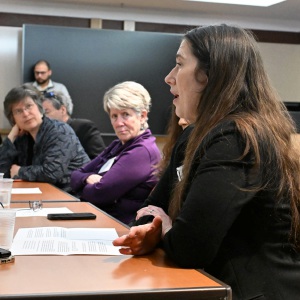Speaking of Nature: Drama at the feeders: The arrival of winter means the arrival of some foul-weather friends

A male downy woodpecker plays peekaboo with a blue jay on my deck. Every time the jay moved, the woodpecker would move to the opposite side of the branch and then watch what the jay was doing. PHOTO BY BILL DANIELSON
| Published: 01-22-2024 6:00 AM |
It appears as though winter has finally arrived. November and December (most of which is technically autumn) were very mild and all through the Christmas break the high temperatures were consistently above freezing. This resulted in little to no snow for most of us and anyone who feeds the birds in their yard may have noticed a dearth of our little feathered friends. This can be very disappointing, but it is not unusual by any means.
With the temperatures being relatively warm and the ground free of snow, the local birds just don’t need our help as much as one might think. There are plenty of places to look for food where the risk of predictability doesn’t make them such easy targets for Sharp-shinned and Cooper’s Hawks. These two raptors present a clear and present danger and small birds must be on constant alert while they also struggle to find enough food to stay alive. Fanning out across the landscape is a good way to reduce the risk of predation.
So, week after week it seemed like there just weren’t many birds around. However, experience informed me that we were just a single snowstorm away from seeing the crowds at the feeders double or triple in size. Reliable sources of food located at well-stocked and well-maintained feeders are simply too valuable to ignore when the weather turns nasty. In this regard, many of our local birds can be fairly described as foul-weather friends. As an aside, it was an absolute agony not to write the phase as “fowl-weather friends,” but we are discussing passerines and not waterfowl. Still, so tempting.
Anyway, as I predicted, the arrival of snow and cold temperatures really changed things on the ground.
A simple example would come in the form of the numbers of Mourning Doves (Zenaidamacroura) that visited my deck before and after the first big storm of the year. On Saturday, Jan. 13, I recorded 14 individual birds. On Sunday, Jan. 14 (before the storm actually arrived) I recorded 17 individuals. But on Monday, Jan. 15, with a fresh coating of snow and a low temperature of only 8 degrees Fahrenheit at sunrise, I recorded 48 Mourning Doves on my deck at the same time.
Apparently, the existential threat of predation was not as important as the more immediate threat of starving to death.
I also noticed that the number of Blue Jays (Cyanocitta cristata) increased rather dramatically that weekend. By the time Jan. 15 rolled around a horde of 15 Blue Jays descended on my feeders in a flurry of blue chaos! That, my friends, is a lot of energy in one place and it was an absolute riot to watch how the other birds responded. The finches and sparrows simply got out of the way and the chickadees continued to visit the feeders, but they got in and out quickly. The female Red-bellied Woodpecker (Melanerpescarolinus) held her ground and would tolerate none of the jays’ nonsense, but the response of a male Downy Woodpecker (Dryobatespubescens) was the most hilarious of all.
The little male was on alert, but he didn’t seem particularly alarmed. Instead, he decided to peekaboo with the jays as they took turns arriving and departing from the deck. There is a small birch branch near my feeders and the male downy used it as cover. Every time a jay arrived, the woodpecker would scoot around the branch so that it was between him and the larger jay. If he had been truly concerned, then he would simply have flown away. This particular woodpecker seemed to have found a game that he enjoyed and so he stayed put.
Article continues after...
Yesterday's Most Read Articles
 Vehicle collides with school bus causing minor injuries in Montague City
Vehicle collides with school bus causing minor injuries in Montague City
 Laid-off Kennametal employees ponder what’s next
Laid-off Kennametal employees ponder what’s next
 AG pledges to help fight opioid crisis in visit to Greenfield
AG pledges to help fight opioid crisis in visit to Greenfield
 Termination of $300K federal grant presents ‘an institutional setback’ for PVMA
Termination of $300K federal grant presents ‘an institutional setback’ for PVMA
 Springfield man held without bail in case of September foot pursuit in Greenfield
Springfield man held without bail in case of September foot pursuit in Greenfield
 HS Roundup: Athol baseball’s bats get rolling in 19-5 win over Turners Falls (PHOTOS)
HS Roundup: Athol baseball’s bats get rolling in 19-5 win over Turners Falls (PHOTOS)
The photograph that I have selected for this week captures the nature of the interaction perfectly. The red feathers on the back of the head identify this bird as a male. The fact that he is on “alert” is shown by the fact that his tail feathers are splayed out and this also happens to have resulted in the fact that the outermost tail feathers, which are decorated with black spots, are hidden from view. However, the small size of the bird identifies him as a Downy Woodpecker. Also, note the distinct shape of the central retrices (the fancy scientific term for the larger tail feathers). Elongated and tapered to a sharp point, these feathers are used to help prop a woodpecker up against a tree, while reducing the energy required.
This particular photo shows the woodpecker peeking around the edge of the birch branch as he monitors the position and the posture of a Blue Jay on the far railing. Every time the jay moved, the woodpecker would shift position to put the branch between them. This was the best photo that allowed me to show you both birds at the same time.
So, with snow on the ground and low temperatures dominating for the next few days, enjoy the birds while you can. We are still in an El Nino weather pattern, so the milder temperatures will likely return and this may result in the reduction of snow on the ground and birds at our feeders. That being said, there is still great fun to be had in watching the drama at your feeders. Get to know the regulars and keep your eyes peeled for someone new and interesting.
Bill Danielson has been a professional writer and nature photographer for 26 years. He has worked for the National Park Service, the US Forest Service, the Nature Conservancy and the Massachusetts State Parks and he currently teaches high school biology and physics. For more in formation visit his website at www.speakingofnature.com, or go to Speaking of Nature on Facebook.






 Sounds Local: Cover bands abound at the Shea: Big Yellow Taxi will perform much of Joni Mitchell’s ‘Ladies of the Canyon’ this Saturday
Sounds Local: Cover bands abound at the Shea: Big Yellow Taxi will perform much of Joni Mitchell’s ‘Ladies of the Canyon’ this Saturday Speaking of Nature: A surprise in my maple tree: Porcupines just want to find something tasty to eat and be left alone
Speaking of Nature: A surprise in my maple tree: Porcupines just want to find something tasty to eat and be left alone Little pillows of golden goodness: The beignet recipe of your dreams, courtesy of our beloved local Wells Provisions
Little pillows of golden goodness: The beignet recipe of your dreams, courtesy of our beloved local Wells Provisions The cost of addiction: New novel draws on Valley backdrop to explore how substance use upends people’s lives
The cost of addiction: New novel draws on Valley backdrop to explore how substance use upends people’s lives
